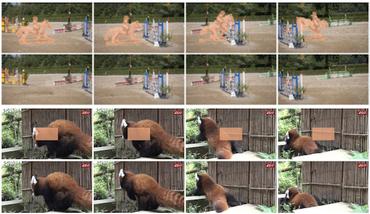Video Inpainting of Complex Scenes
We propose an automatic video inpainting algorithm which relies on the optimisation of a global, patch-based functional. Our algorithm is able to deal with a variety of challenging situations which naturally arise in video inpainting, such as the correct reconstruction of dynamic textures, multiple moving objects and moving background. Furthermore, we achieve this in an order of magnitude less execution time with respect to the state-of-the-art. We are also able to achieve good quality results on high definition videos. Finally, we provide specific algorithmic details to make implementation of our algorithm as easy as possible. The resulting algorithm requires no segmentation or manual input other than the definition of the inpainting mask, and can deal with a wider variety of situations than is handled by previous work. 1. Introduction. Advanced image and video editing techniques are increasingly common in the image processing and computer vision world, and are also starting to be used in media entertainment. One common and difficult task closely linked to the world of video editing is image and video " inpainting ". Generally speaking, this is the task of replacing the content of an image or video with some other content which is visually pleasing. This subject has been extensively studied in the case of images, to such an extent that commercial image inpainting products destined for the general public are available, such as Photoshop's " Content Aware fill " [1]. However, while some impressive results have been obtained in the case of videos, the subject has been studied far less extensively than image inpainting. This relative lack of research can largely be attributed to high time complexity due to the added temporal dimension. Indeed, it has only very recently become possible to produce good quality inpainting results on high definition videos, and this only in a semi-automatic manner. Nevertheless, high-quality video inpainting has many important and useful applications such as film restoration, professional post-production in cinema and video editing for personal use. For this reason, we believe that an automatic, generic video inpainting algorithm would be extremely useful for both academic and professional communities.
PDF Abstract


